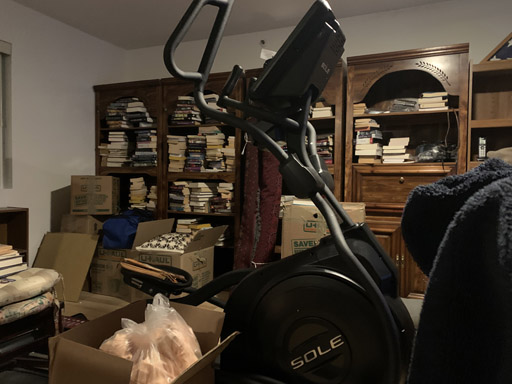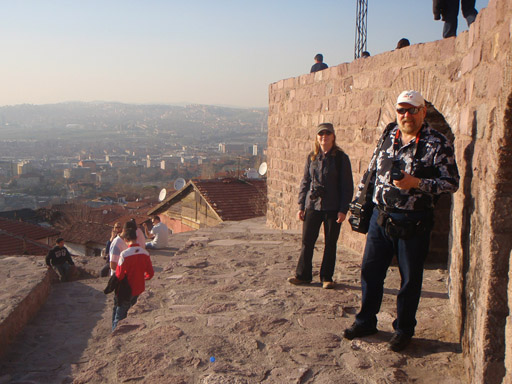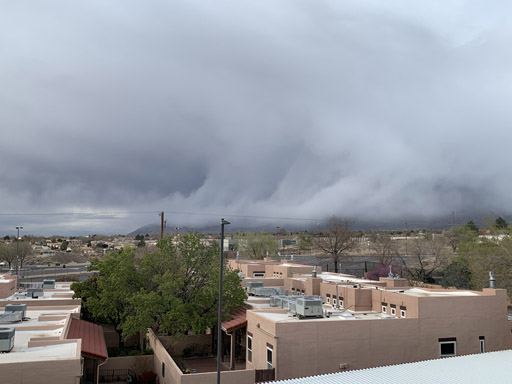The 9th issue of Nathan Toronto’s paperback magazine Bullet Points is now available, with a reprint story by yours truly (“Wolf Time”). Bullet Points “captures the complexity, tragedy, and hope of warfare and violence in human and nonhuman society,” and this issue has an AI theme.
Bullet Points is generously sized, and packs a lot of words between its covers. Feel free to check it out.
The process of settling into new quarters continues. The living room, pictured here, is almost ready for actual living. The Berlin Wall of cardboard boxes that once blocked access to the bookshelves is gone. In the foreground is our elliptical trainer, which has finally emerged from its container. As the container took up about as much space as a large dining table, it’s a relief to see it gone.
Most rooms are navigable and capable of functioning more or less as intended, with the single exception of my man cave/office/library. We’re tackling it last because it’s less important to daily living, which leaves me working with a laptop in the living room.
I’ll look forward to being able to cook. No pots or pans have so far surfaced. The microwave isn’t really a substitute for home cooking.
I’ll look forward to living in a home, and not something like a bus station.
It’s 2009, and I’m in Turkey to research my novel Deep State. Standing behind is Melinda Snodgrass, and Patricia Rogers is behind the camera.
I’m in the smog-swathed capital of Ankara, the city known to the Hittites as Ankuwash, to the Romans as Ancyra, and to the Ottomans as Angora. Ankara is a modern, largely secular city, with more than 20 universities, but looming above is the acropolis topped by its citadel, mostly Byzantine and Turkish but with foundations that go back to the Phrygians.
Walking through the citadel’s gates really is like walking into another, older world. There’s an entire city inside the walls. Men smoke in doorways or play backgammon, old women in headscarves walk up the steep paths carrying enormous bundles of Angora wool on their backs, and kids kick footballs around. Even little girls wear headscarves, which I hadn’t seen anywhere else. Groups of teenage girls in headscarves and ankle-length overcoats giggle and snap selfies of each other. People seem poorer than elsewhere in the city.
The citadel plays a part in Deep State, as the place where Dagmar and Ismet, her love interest, first connect, when he takes her hand and leads her along the top of a connecting wall to a bastion.
A little nervous, I walked to the bastion myself, but no one held my hand.
A storm swathes the Sandia mountains, as seen from our balcony.
So we’ve made the big move, and we’ve sacrificed the joys of country living for the excitement of the big city. As you can see. Excitement everywhere you look.
The move itself took 2 days, the first to pack everything, the second to transport it and unload the trucks. The movers finished at 9pm and I gave them each a nice tip.
There was enough room for all the furniture we cared to bring— lots of bookshelves— which surprised me. Perhaps the apartment is a tesseract.
It’s nearly two weeks since we moved, and to give you an idea of the state of our new digs, here’s a photo of my office/man cave/library. A corner of my office chair is peeping out from behind some boxes.
The sad fact is that I’ve unloaded dozens of boxes, but it doesn’t seem to make any difference. A Berlin Wall of cardboard still marches through almost every room. The only room so far cleared of debris is the kitchen, which means I could cook something if I could only find some pots and dishes.
Part of the reason it’s taking so long is that we (mostly Kathy) have been dealing with our country house— all the stuff we didn’t bring with us needed to be shoveled out, the place had to be prettified for the hordes swarming in to make us offers, and ordinary upkeep had to be done. So we’re not free of the country yet.
We’re both exhausted and operating through brain fog dense enough to make it hard to see the floor beneath our feet. We could really use a couple weeks in the tropics.
Maybe I’ll settle for a cocktail or two.




